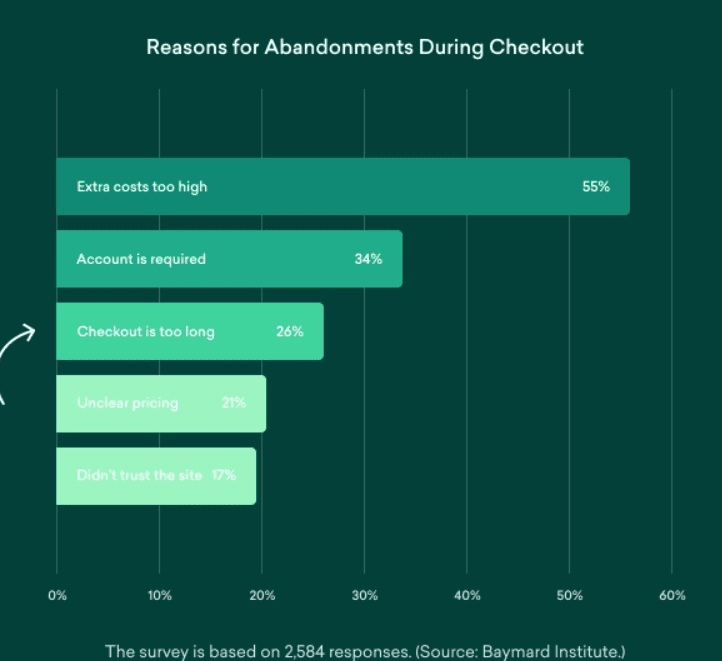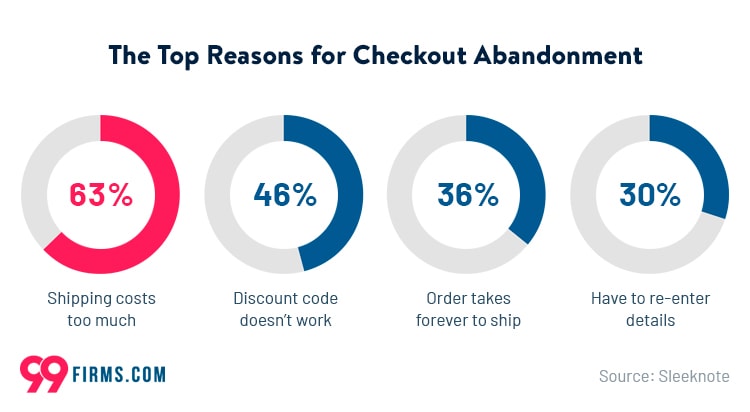There are numerous reasons why users abandon the checkout process in the middle. While browsing, some people aren’t quite ready to buy, while others are window shopping or saving items for later.
There isn’t much that can be done about those, shopping cart abandonment data reveal that eCommerce businesses can do a lot to improve their checkout process and boost conversions.
However, we have shared the amazing Shopping Cart Abandonment statistics, facts and latest trends that may help you understand better about shopping cart abandonment.
Contents
- 20 Best Shopping Cart Abandonment Statistics in 2024
- 1. The average shopping flow abandonment rate in 2020 was 69.57 percent.
- 2. Mobile users abandon their devices at an even higher rate of 85.65%.
- 3. Every year, eCommerce firms lose $18 billion in sales.
- 4. Checkout Optimization Has the Potential to Increase Conversions by 35.62 Percentage
- 5. About 55 percent of users abandon carts because they must re-enter information.
- 6. A typical checkout flow contains 23.48 form elements and 14.88 form fields.
- 7. People abandon their fashion buy orders in 40% of situations due to poor online functionality.
- 8. Spain had the highest cart abandonment rate in 2021, at 86.15 percent.
- 9. 55% of customers will abandon a purchase if they have to re-enter their credit card or shipping information.
- 10. Free shipping was mentioned by 79 percent of individuals as one of the reasons they would shop online.
- 11. Personalizing Retargeted Ads Can Lead to ROIs of More Than 1,300%
- 12. The streamlined checkout process can have up to seven form fields and twelve form elements.
- Conclusion
20 Best Shopping Cart Abandonment Statistics in 2024
1. The average shopping flow abandonment rate in 2020 was 69.57 percent.
This average cart abandonment rate indicates that approximately seven out of ten shoppers will abandon their purchases. This figure is based on data from 41 distinct research on online shopping cart abandonment.
Source: Sleeknote
2. Mobile users abandon their devices at an even higher rate of 85.65%.
“The smaller the screen size, the less likely a customer is to purchase,” explains Barilliance. “This is worrisome because, for the first time ever, more digital purchasers will shop on cellphones rather than desktop computers.”
3. Every year, eCommerce firms lose $18 billion in sales.
In addition, according to Forrester’s research, another $4 trillion in merchandise will be lost in 2022 due to eCommerce cart abandonment. Clearly, this is an issue that the eCommerce business cannot afford to ignore.
4. Checkout Optimization Has the Potential to Increase Conversions by 35.62 Percentage
The good news is that e-commerce businesses aren’t condemned to suffer from cart abandonment.
Conversions may be raised by an astounding 35.62 percent by applying the correct checkout optimization tactics, according to experts.
While attaining this figure will not be simple, it is certainly doable.
At the end of the day, it all comes down to figuring out what’s wrong and making a determined effort to enhance e-commerce site design, promotions, products, checkout flow, and so on.
5. About 55 percent of users abandon carts because they must re-enter information.
More specifically, 30 percent of consumers will abandon the purchase if they have to re-enter their credit card information, while 25 percent will abandon the transaction if they have to re-enter their shipping information.
According to cart abandonment statistics, 46 percent of customers abandon their shopping cart if a discount coupon does not function.
6. A typical checkout flow contains 23.48 form elements and 14.88 form fields.

The complexity and duration of a shopping cart are two other important elements that influence the likelihood of someone completing a purchase.
According to the Baymard Institute, having a checkout process that is too long or too confusing is the reason why more than a quarter (26 percent) of shoppers abandon.
7. People abandon their fashion buy orders in 40% of situations due to poor online functionality.
Statistics show, for example, that there is a strong association between slow websites and shopping cart abandonment. Some elements, such as the ability to see products up close or benchmark them, are critical for someone purchasing stylish items.
Other users stated that very sluggish shipping caused them to abandon an order (36 percent ). Many people were also concerned about the product’s quality (35 percent ).
8. Spain had the highest cart abandonment rate in 2021, at 86.15 percent.
For comparison, the overall desertion rate for the year was 77.13 percent. Statistics on shopping cart abandonment suggest that, unlike
Spain, some other nations had lower-than-average rates, such as the Netherlands with 65.49 percent and the United States with 71.86 percent. France and the United Kingdom have greater rates of digital shopping cart abandonment, with 76.81 percent and 76.01%, respectively.
9. 55% of customers will abandon a purchase if they have to re-enter their credit card or shipping information.

Continuing on from my previous argument, this figure illustrates that any significant redundancy in the checkout process has a negative influence on conversions.
According to Statista, 30 percent of shoppers will abandon a purchase if they have to re-enter their credit card information, and 25 percent will abandon a purchase if they have to re-enter their shipping information.
10. Free shipping was mentioned by 79 percent of individuals as one of the reasons they would shop online.
As a result, by providing this value to customers, brands may be able to reduce prospective cart abandonment rates. Incentivizing clients to complete their purchases online could be an excellent method to increase conversion rates. Customers also prefer free returns and exchanges (54 percent), as well as same-day shipment (42 percent ).
11. Personalizing Retargeted Ads Can Lead to ROIs of More Than 1,300%
Basic retargeting is beneficial for returning qualified leads to your e-commerce site. It has a greater impact, though, when retargeted ads are individualised.
Brands who segmented separate remarketing audience lists for consumers who behaved differently saw ROIs of over 1,300 percent.
12. The streamlined checkout process can have up to seven form fields and twelve form elements.
A straightforward checkout flow necessitates reducing the amount of form components and fields. As a result, instead of using two fields to acquire a customer’s name and surname, you can use just one. Address lines that would normally take up multiple fields can be shortened to one.
For comparison, the average unoptimized checkout procedure now contains roughly 24 form elements and 15 fields.
Conclusion
These shopping cart abandonment statistics show that there’s a lot of work to be done, especially when it comes to the checkout design and how easy it is for people to use the site. This, of course, can help conversion rates.

